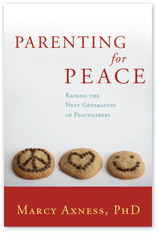We tend to throw around the word “attachment” a lot when talking about kids and parenting, so let’s make sure we’re all talking about the same thing: attachment is a measure of the security of relationship between a child and those one or two or three adults with whom that child is in consistent contact. We now recognize that healthy (secure) attachment is a fundamental form of nourishment for a child’s growing brain. In particular, attachment fosters rich circuitry in the area of the brain that mediates social and emotional functioning. A parent’s ability to be present for a child is fundamental to fostering this brain circuitry needed to regulate attention — therefore, basic ADHD treatment. Mounting research suggests that the social brain is the basis for the child’s lifelong success — in school, at home, and out in the world!
 When we distill the attachment and brain development research, it is remarkably consistent with the teachings of ancient spiritual traditions as well as modern humanist psychology: for a child to develop secure attachment (the basis for all future development), the child first and foremost needs regular doses of the undistracted, full presence of a primary attachment figure. What the past decade of brain science has discovered is that a parent’s ability for this kind of presence goes hand in hand with the an important set of other right-hemisphere, social brain skills: empathy, autobiographical memory and an array of other social-emotional capabilities.
When we distill the attachment and brain development research, it is remarkably consistent with the teachings of ancient spiritual traditions as well as modern humanist psychology: for a child to develop secure attachment (the basis for all future development), the child first and foremost needs regular doses of the undistracted, full presence of a primary attachment figure. What the past decade of brain science has discovered is that a parent’s ability for this kind of presence goes hand in hand with the an important set of other right-hemisphere, social brain skills: empathy, autobiographical memory and an array of other social-emotional capabilities.
Presence: To Be With
It is only with the presence of a healthily developed right hemisphere that we are able to be with another — to be present in the full and complete way that is needed by a child. (We all know that feeling of talking to someone who just isn’t quite fully with us — as in the classic party conversation with someone whose eyes are darting around the room looking for who might be more interesting!)
Gabor Maté in his extraordinary book Scattered: How Attention Deficit Disorder Originates and What You Can Do About It, traces the connection between being present and attending — which he proposes is a fundamental, active form of loving. To attend to a child is to be present for them, attuned and responsive to their emotional cues. It is through the weeks, months and years of these attuned, responsive relational encounters that a child’s self-regulating brain systems wire up: they wire up to mirror the relational style of the adult! Thus, suggests Maté, a child displaying the kinds of impaired self-regulating abilities that often lead to ADHD treatment, for example, has indeed suffered a deficit of attention when it was needed — in the early years.
Relationships with a selective few adults, not sensory flooding, are the most important form of experience for the growing mind. Adults who are sensitive to a child’s signals, who can offer consistent and predictable behaviors, and who care about the child’s internal experiences are those that are likely to foster a secure attachment. — Daniel J. Siegel, M.D., UCLA Dept. of Psychiatry
How Attachment Styles Get “Passed Down”
Leading-edge research from the newly aligned fields of brain science and attachment theory has revealed an astonishing principle: the factor that most reliably predicts a child’s secure, healthy attachment is the ability of that child’s parent (or consistent caregiver) to make sense of his/her own early history.** This autobiographical ability tends to go hand in hand with the ability to be present in the way that nourishes a child’s growing sense of self. This is a kind of counter-intuitive, puzzling connection: What does me being able to tell my childhood story have to do with how good a parent I am??! Turns out that this has to do with some newly-discovered principles of brain development and function:
- The natural mode of brain functioning for the young child is governed primarily by the right hemisphere (as in the phrase, “right brain.”) This is the mode in which key lifelong brain capacities are wired, which lay a foundation for healthy social-emotional functioning and a strong sense of self.
- But when a child’s need for attachment is thwarted (what I call “malattachment”) through chronic emotional or physical stress or abuse – or even the more subtle emotional “non-presence” of a parent – the child’s adaptive survival response is to prematurely engage the left hemisphere of the brain, which has to do with facts, logic and thinking. You see, under conditions of malattachment, it is very painful for a child to continue to “live” in the relationship-seeking right hemisphere, which has to do with imagination, creativity, and feeling.
- When a child is prematurely “living in the left brain,” the development of key right brain area skills (including what we have come to call “emotional intelligence” or “E.Q.”) is dangerously undermined. One such skill is autobiographical memory. Thus, a child who has spent much of childhood engaging life through the rational, fact-based left brain is more likely to grow up to be an adult who is less likely to be able to tell the story of his or her childhood in a way that hangs together and makes sense. They will more likely have only disjointed fragments of memories — random pieces of a puzzle, but without a big picture that fits together reasonably well.
- And vice versa: the ability to easily make sense of and relate one’s early story is good evidence for one’s own healthy attachment history. But can’t we simply determine to “do better” for our own child? Why does our story make such a difference?
It is of key importance to understand that it isn’t so much what happened to you as a child that influences how you are as a parent, but how you come to make sense of what happened to you.
Feeding the Brain with Present Parenting
 This finding from attachment theory should be at the top of a parent’s “To Do” list: the most powerful factor determining whether a child will be able to develop a healthy, secure attachment, is the ability of the child’s parent to tell a coherent narrative about his or her own early life — in other words, his or her own attachment story! In plain and practical terms, it isn’t what parents do as much as who parents are!!
This finding from attachment theory should be at the top of a parent’s “To Do” list: the most powerful factor determining whether a child will be able to develop a healthy, secure attachment, is the ability of the child’s parent to tell a coherent narrative about his or her own early life — in other words, his or her own attachment story! In plain and practical terms, it isn’t what parents do as much as who parents are!!
It has been striking to find in my coaching practice that there are so many parents who do indeed have difficulty “just being” with their children — which is of course all children want! (“Mommy, I want you to play with me!”) I myself struggled with this challenge, so have particular empathy and understanding of this somewhat “secret” dynamic at work in so many parents’ lives.
What research now reveals is that though history is past and cannot be changed…and “working through” one’s history in therapy can be a long, expensive process…it is possible to immediately begin developing the capacity for presence by working directly on “exercising” the right brain and facilitating greater levels of “whole brain” integration! This is done through myriad kinds of experiential approaches including meditation, guided imagery, hypnosis, mindfulness or mind-body exercises, narrative processes, art, movement, games, and even something called Brain Gym!
Magical Child author Joseph Chilton Pearce has said, “Our children can never be who we tell them to be, they can only be who we are.” I’ve come to believe that our children’s potential horizons aren’t limited by what we are, but are broadened by our striving. Our children’s healthy development calls on us to pursue our own development. Maté concludes his book by pointing out that “The origins of the word attend is the Latin tendere, ‘to stretch.’ Attend means to extend, to stretch toward.
“If we can actively love, there will be no attention deficit and no disorder.”
[** We’re talking about the ability to relate one’s story to another adult or counselor, not to one’s child!]
Images by:
Corbis/Royalty-free
Ross Griff under Creative Commons license
Corbis/Royalty-free
Tags: ADD, adhd, attachment, brain development, Dan Siegel, Gabor Mate, presence, social brain



My husband and I make it a point that we both express connectedness with our children. We always attend to their needs and go out as a family most of the time. We play with our kids in an arcade and enjoy some outdoor activities with them. I can say that attachment to your kids really help their development as they grow. They are both doing good in school, at home and in any activity which they get involved with.
When I was younger my classmates told me that I might have ADHD. I never have the courage to go to the doctor. Now I realized that I may have it and drinking alcohol is my way of releasing it.